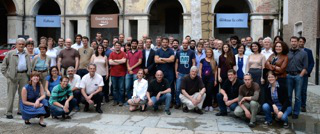Speaker
Dr
Joern Schwandt
(University of Hamburg)
Description
Studies of surface radiation damage and the impact of the charge distribution on the outer surface of segmented silicon sensors are ongoing at Hamburg University since 2007. In this talk, selected results obtained from measurements on test structures and strips sensors will be presented:
- dose and electric field dependence of the effective oxide charge density, Nox,
- dose and electric field dependence of the surface-current density, Jsurf,
- attempts to determine the energy distribution of the interface trap density, Dit, as function of radiation dose,
- study of the charging and discharging of radiation-induced border traps when changing the biasing conditions,
- influence of Nox on the breakdown characteristics of segmented p+n sensors,
- influence of Nox on the electric field and the charge collection of strip sensors,
- time and humidity dependence of the resistivity of the outer surface (passivation layer) of strip sensors and its influence on the charge collection.
It is concluded that the number of parameters which influence surface radiation damage depends is so large, that a complete systematic study is practically impossible and certainly beyond the capabilities of a single group. However, based on the studies presented, extreme values of parameters like Nox, Dit, and Jsurf for maximal electric fields typical for segmented silicon sensors are available. They can be implemented into TCAD simulations in order to study the joint effects of surface and bulk radiation damage for the radiation fields, which are relevant for the HL-LHC (and also the European XFEL). In addition, the importance of verifying by TCAD simulations
Primary author
Dr
Joern Schwandt
(University of Hamburg)
Co-authors
Dr
Eckhart Fretwurst
(University of Hamburg)
Prof.
Erika Garutti
(University of Hamburg)
Mr
Ioanis Kopsalis
(University of Hamburg)
Prof.
Robert Klanner
(University of Hamburg)

